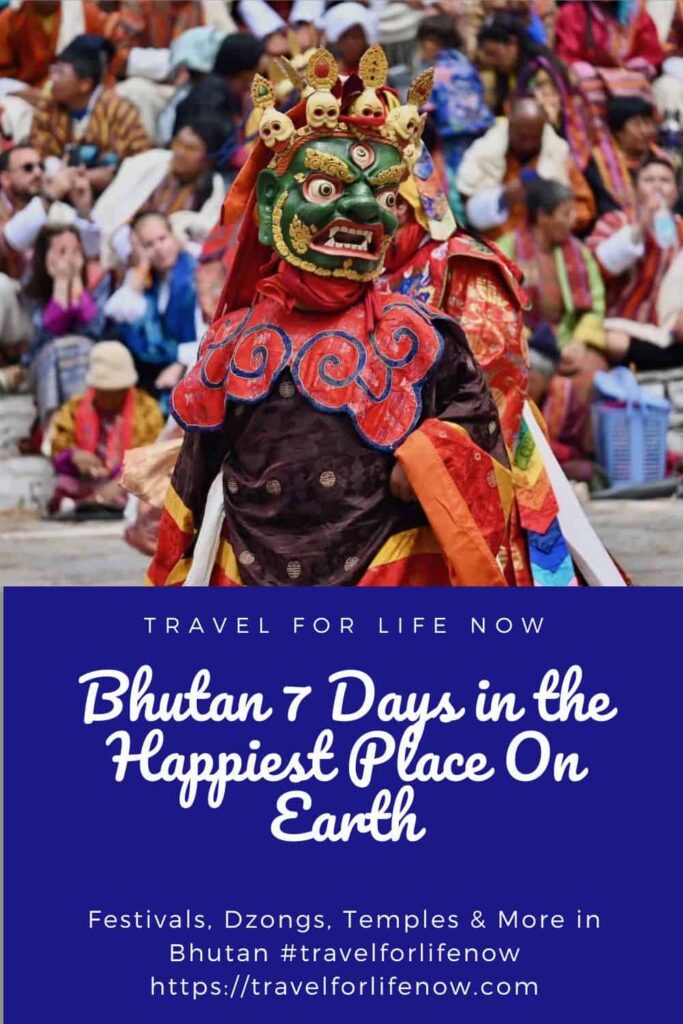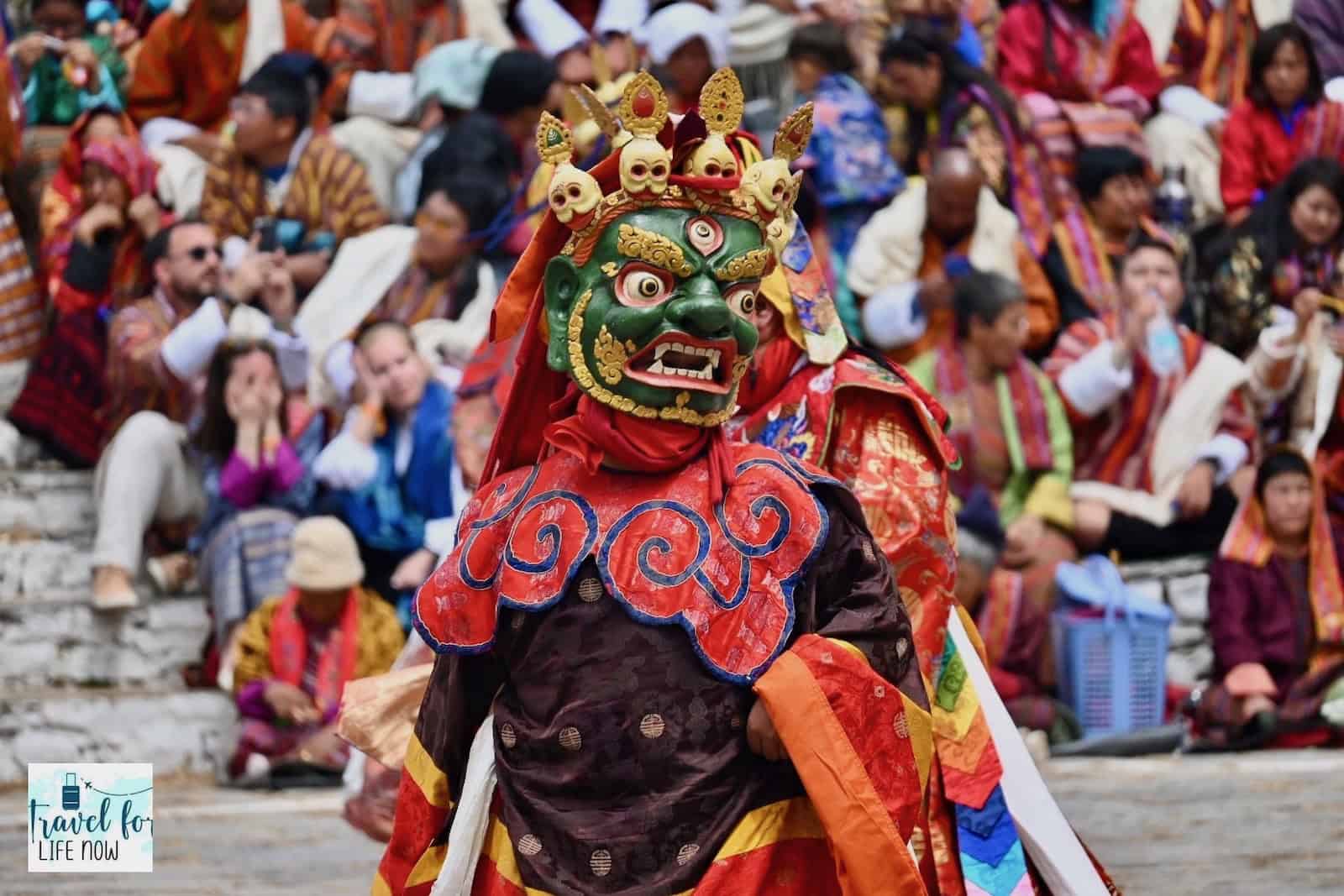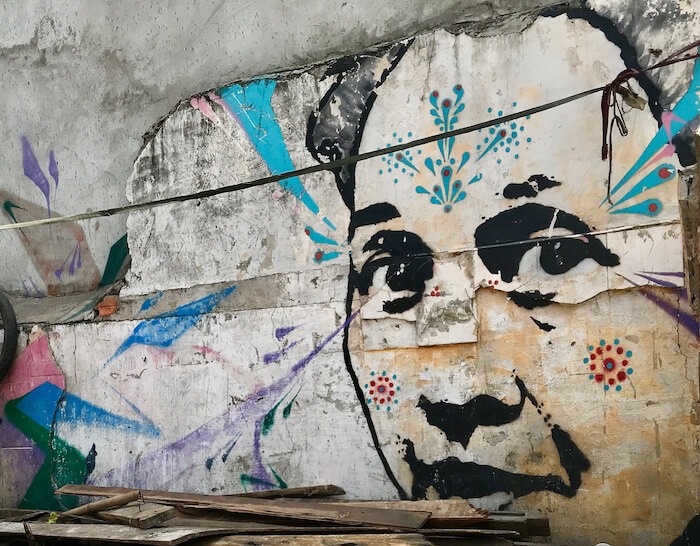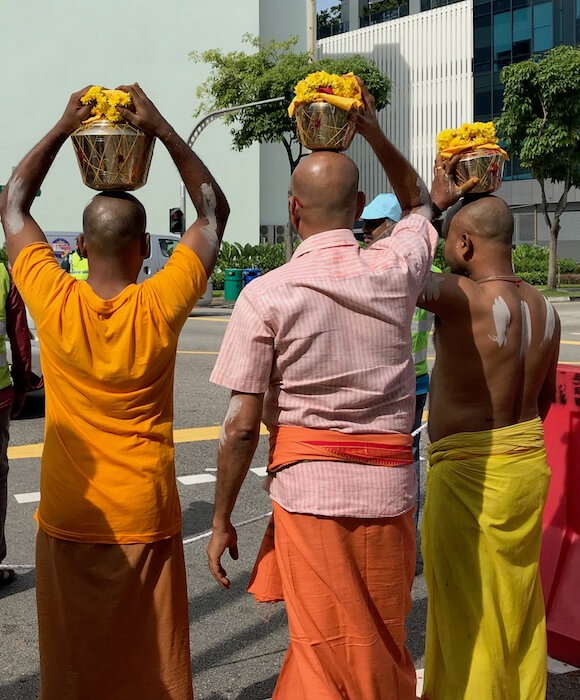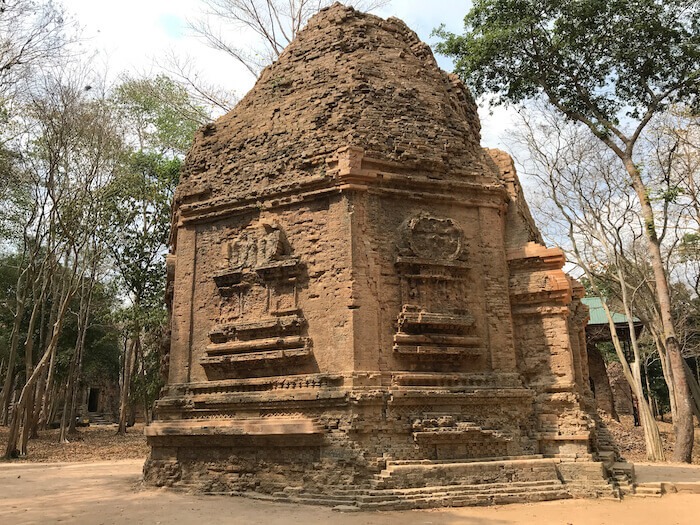Bhutan: 7 Days In The Happiest Place In The World
By Sue Davies and Regina Ang
“Welcome to Bhutan, your Majesty, ladies and gentlemen,” announced the flight attendant.
Reggie and I looked at each other. Excited for the adventure ahead. We had just touched ground at Paro Airport, one of the most difficult airports in the world to land on. We had our eye on Bhutan for a while and now we were there.
The mention of “Your Majesty” puzzled us, but we were mainly focused on retrieving our bags from the overhead bin.
Suddenly, we noticed a buzz in the plane. Across the aisle, people were taking pictures out of their windows. We squirmed around trying to figure out what they were looking at. A red carpet was rolled out on the tarmac and military personnel were lined up. Someone said, there goes the King and Queen of Bhutan! We didn’t realize that we had flown with royalty!
So began our week in Land of the Thunder Dragon. Also known as the happiest place on earth. And for us, the place where mountains become hills.
We were off to an auspicious start.
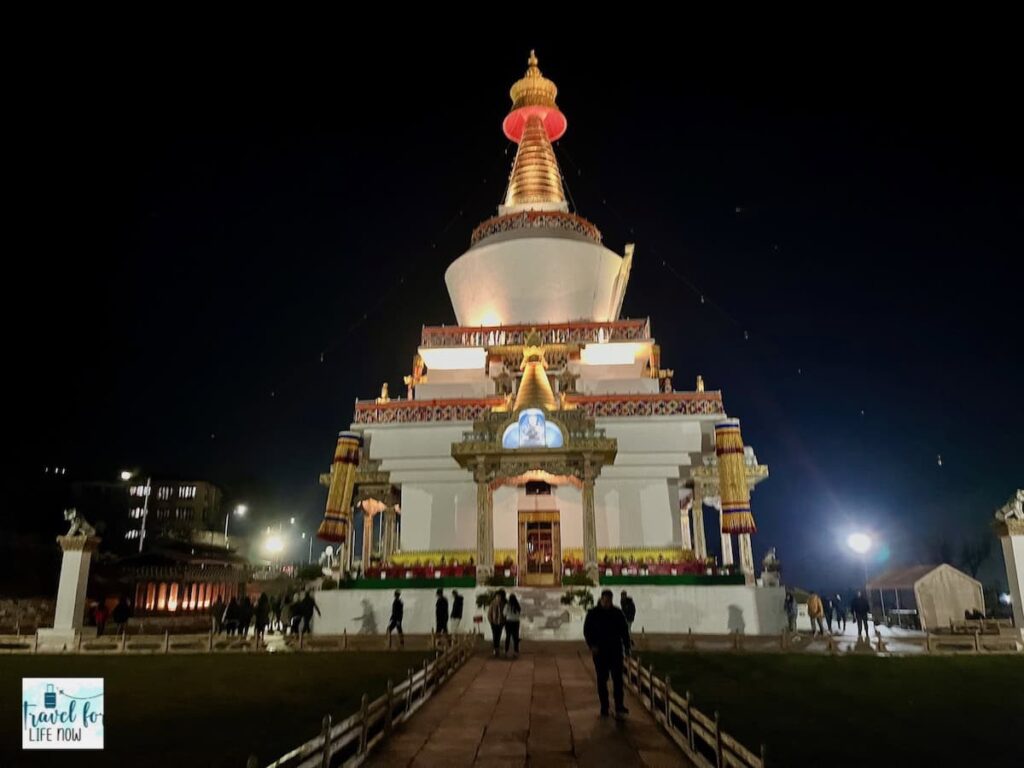
Overview Of Our Itinerary
Day 1:
After landing at the Paro Airport, we drove to Thimphu with a short stop to view the Tamchog Lhakhang (Monastery).
Day 2:
After overnighting in Thimphu, we saw the National Memorial Chorten and drove over the Dochula Pass to Punakha.
Day 3 & 4:
In Punakha: we went to the Talo festival, the Punakha Dzong, Khamsum Monastery, the longest suspension Bridge, and Chimi Lhakang Monastery.
Day 5:
We drove back to Paro via Thimphu to see the tallest statue of sitting Buddha in the world at Kuensei Phonedrang, the Takin Preserve, Tashichho Dzong, the National Museum of Bhutan, and the Paro Festival.
Day 6:
We hiked up to the Tiger’s Nest
Day 7:
Our last day in Bhutan. En route to the airport, we were able to catch a final festival in Paro Dzong, and then hiked to Dzongdrakha Goenpa.
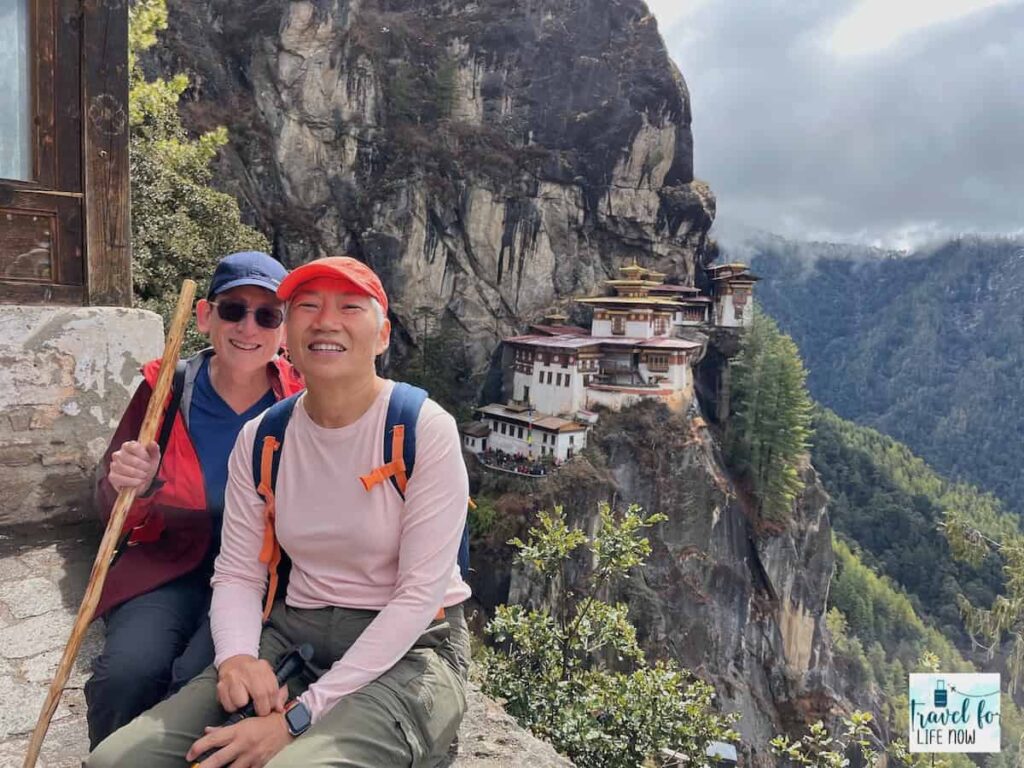
Making Hills Out Of Mountains
The first thing we discovered in Bhutan is that what we call a mountain, they call a hill.
“Look at that beautiful mountain,” I said.
It’s not a mountain, it’s a hill, said Dorji, our guide.
We gave him a puzzled look. It was a big mountain for us. He explained that anything under 14,000 feet was a hill. Being surrounded by the peaks of the Himalayas, the Bhutanese have a very different perspective. The mountains are considered sacred. This is one reason you hear about mountain climbing in Nepal and Tibet but never in Bhutan. There are, however, many wonderful treks to do in Bhutan and many hills to climb.
The Paro airport is 7,300 feet above sea level, ringed by mountains. This makes it the most dangerous airport in the world. Pilots must have a visual on the short runway. High winds, fog, and clouds can make it impossible to land.
Bhutan borders Tibet and China to the north and northeast and India to the west and south.
Tracing The Flight Of Guru Rinpoche Up To The Tiger’s Nest
Legend has it that Guru Rinpoche, the tantric Buddhist master from Tibet who introduced Buddhism to Bhutan, flew on the back of a tigress up a mountain to subdue a demon that was bothering the people of Paro, in the 8th century. Today, this has become the famous site of the Tiger’s Nest Monastery or Paro Taktsang. The temple is built into the side of a mountain or what Dorji would call a 10,240-foot-sized hill.
We wished we could fly up to the Tiger’s Nest like Guru Rinpoche. Instead, we hiked from 6,000 feet to 10,000 feet, through paved paths, rocky ground, stairs, and more. When we were out of breath and ready to quit, we’d stumble upon another stunning view of our intended destination, and we would continue.
Will We Make It?
The hike up took us over 2.5 hours and was worth every steep stair and trail. The last stretch was 700+ stone stairs down and another 250 back up. At that point, we were at 10,000 feet elevation. We slowed down to take in the views every so often (and hide the fact that we needed to catch our breath).
Just before 250 steps back up—the final stretch—we saw a beautiful waterfall. Then it was up to the final stretch of stairs.
Tiger’s Nest is a sacred Buddhist site with temples and shrines built in 13 small caves. The first temple was built around 1508. The temples and shrines have beautiful murals of Buddhist deities. The main temple has an exquisite carved ceiling. Butter lamps and incense give a spiritual feel. No photographs are allowed in the temples, and we had to take off our shoes before entering each. We walked in and out of the temples, sometimes up small sets of stairs. After all that work to get there, it was good to be still and take in the history and holiness.
Then it was time to walk down. The climb down was challenging, especially for bad knees. We took slightly less than 2 hours on the way down.
On Dorji’s advice, we had a massage and a traditional hot stone bath after the climb. Both were exquisite and we highly recommend doing so.
We recommend walking sticks and a good pair of shoes or hiking boots. A good guide is also essential to learn more about the Temples and Shrines. Ponies can be hired and ridden halfway up and down. That still leaves a lot of hiking, and you don’t get the satisfaction of doing the whole day on your own two feet.
The Masked Dancers Of Bhutan
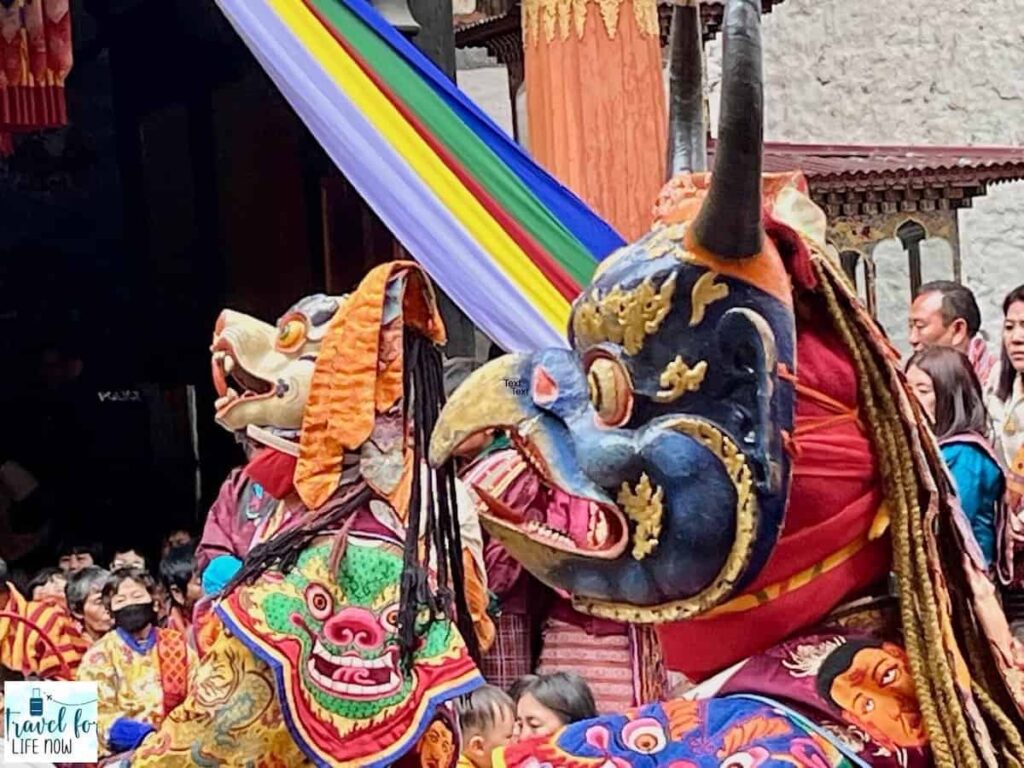
Seeing festivals (Tshechus) and masked dancers was one of the main reasons that we journeyed to Bhutan. We timed our trip to attend two festivals, one at the top of a mountain (excuse me, hill) in Talo and one in Paro. Both were amazing experiences.
The dances and festivals are religious, community experiences. Most last 3 or 4 days and the entire community comes to see the dances. It is said that the dances help the villagers to know which sacred leaders/figures to follow and how to avoid demons in the afterlife.
The masked dance of the drums from Drametse has been declared a UNESCO Intangible Cultural Heritage of Humanity. We did not venture to eastern Bhutan to see this dance in Dramatse, but we were able to see it performed in Paro.
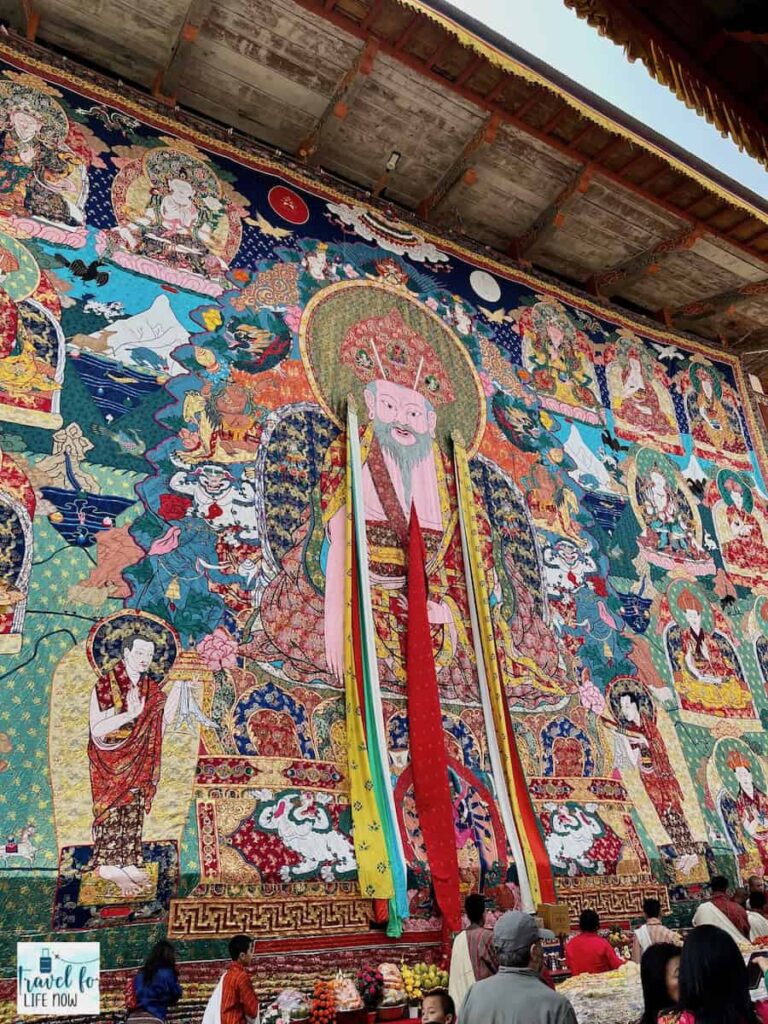
Talo Tshechu And The Masked Dancers
The Talo Tschechu Festival was the first we attended. It took place in a small community at the top of a long, steep, windy road. The entire community was there for all three days. Families arrived in traditional dress—gho for the men and colorful kira for the women. Children were dressed up as well. The families had a picnic while watching the dancers. They shared blankets, cardboard for sitting on, and small chairs. There were about 200 people when we attended.
We were especially excited to see the Thongdrel, a giant tapestry, that is believed to cleanse the sins of the viewer. It is only displayed on the last morning of the festival. The thangka shows the history of Buddhism in Bhutan.
The Talo festival is famous for the Atsara (clowns) as well as the skillful masked dancers. Some of the dances last more than an hour. Dorji related some of the stories that the dancers were telling. We were mesmerized by the dancers and even took a selfie with one of the Atsara dancers.
After our morning at the festival, we had a wonderful picnic lunch nearby. Then we returned to the festival to watch more of the dances and to stroll in through the games and food area. Reggie even had a hand at traditional archery. Bhutan is known for its archery competitions.
Check our video to see the festival up close: https://youtu.be/17BIpsDC2d4
The Masked Dancers Of Paro Tshechu
Paro Tshechu is one of the most popular festivals in Bhutan, attended by families from all over the Paro Valley. It celebrates the birth of Guru Rinpoche, and features masked dances, religious processions, and the unveiling of a Thongdrel.
As we drove into Paro, the first thing we noticed was the cars and people. This was not a small community festival. Paro is one of the main cities in Bhutan and people came from all over. We couldn’t stop taking pictures of the excited children and families as they walked through the path to the dzong where the dances took place.
The festivals take place at the village dzongs or fortresses. Once again, we were mesmerized by the stylistic dancers and the music. The excitement of the crowd was infectious.

Dzongs – Bhutanese Fortresses
Dzongs or fortresses were built as early as the 12th century and used to spread Buddhist religion. Dzong architecture comprises whitewashed walls and wooden roofs with towers in the middle section. Strategically located they were transformed into military strongholds from the 17th century to unify the country. Visiting a dzong or a few is a must when seeing the country as it holds not only historical but also religious and social significance to the Bhutanese.
The Dzongs in Paro and Punakha were especially impressive.
Today, all dzongs have been converted into government administrative buildings, and monasteries that house monks, and serve as sites for social and religious events such as the sacred mask dances.
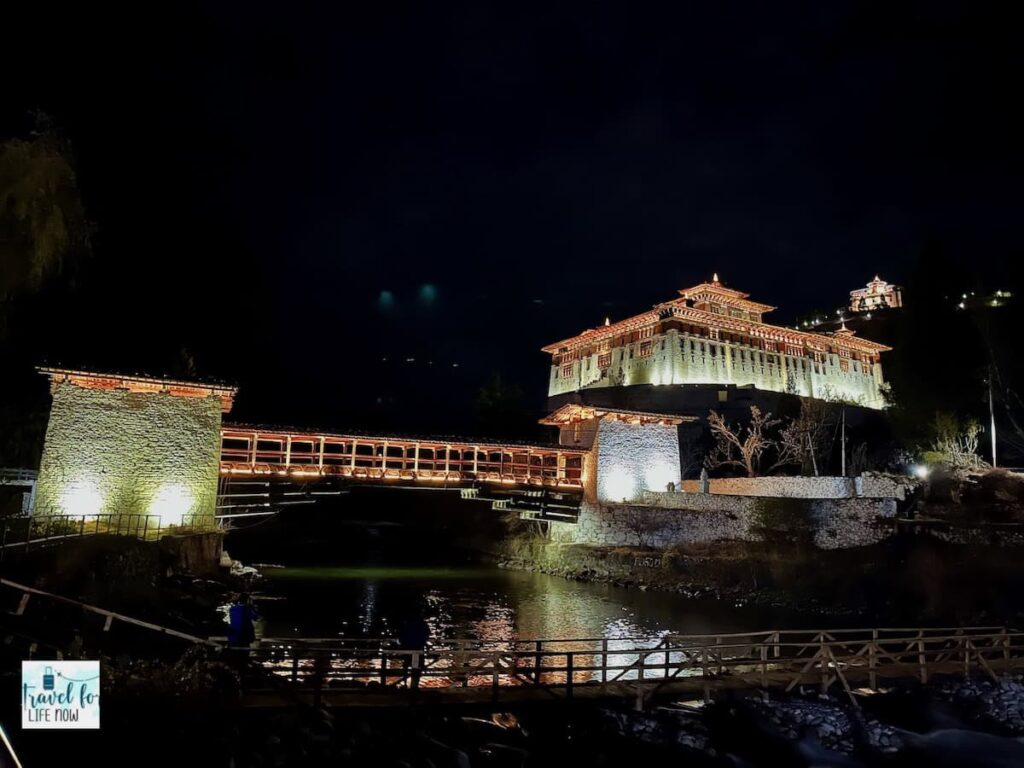
Driving In Bhutan Is An Adventure
When we started planning our trip, we saw the distances between cities and thought we wouldn’t be spending that much time in the car. Then we heard about the 60 km (less than 38mph) speed limit and wondered why. There are no traffic lights in Bhutan.
Yes, that’s correct. There are no traffic lights anywhere. And, we did not see a single traffic accident.
Well, it’s a good thing the speed limit is so low.
Bhutan is full of high mountains, steep valleys, and forests. The roads leading in and out of major cities are punctuated by sharp hairpin turns, some without rail guards on single-lane roads. Suffice it to say that at the end of every drive, we were thankful we were not going any faster and that our driver was careful.
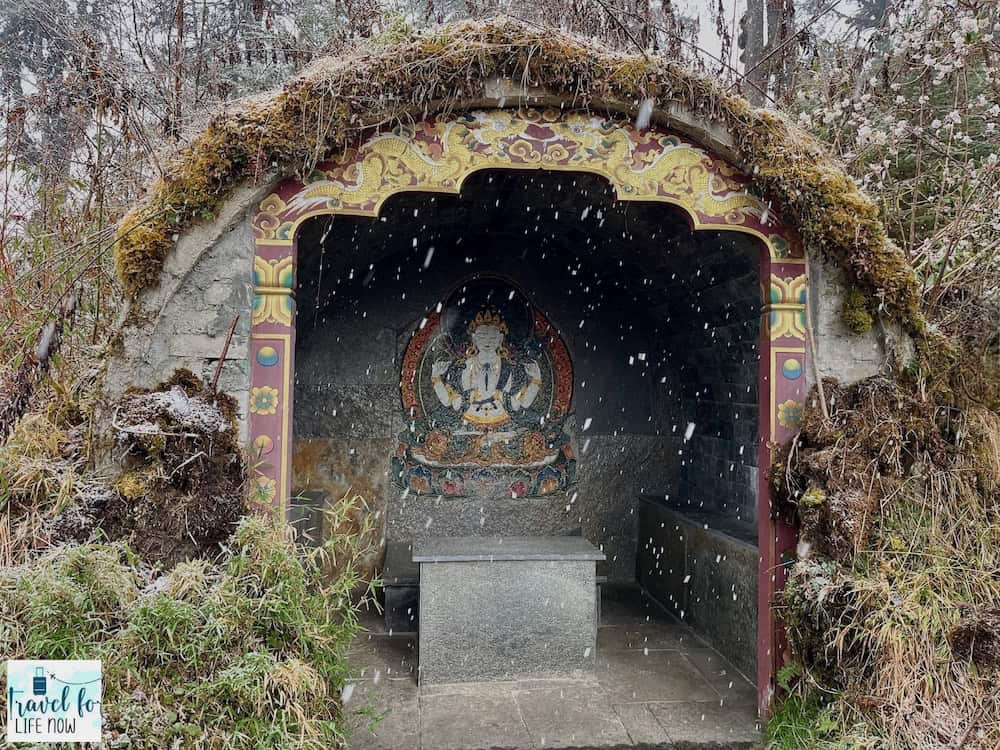
Driving Through Dochula Pass
A drive through Dochula Pass with a stop at the meditation caves is one of the most hyped activities to do in Bhutan. It’s unavoidable if you want to go between Thimphu and Paro. We were told that there are exquisite views of the Himalayas from the top of the pass. We passed through twice and never saw the view due to fog the first time and snow the second.
The 108 Chortens or stupas is a good reason to stop at the top of the pass. They were created by the Queen Mother Ashi Dorji Wangmo as a memorial for the Bhutanese soldiers who died in the battle with Indian insurgents in 2003. The number 108 is a sacred Buddhist number that symbolizes completeness.
We walked to the meditation caves during our second time through Dochula Pass in the snow. It is worth taking the time to see the small caves. They are peaceful and tranquil.
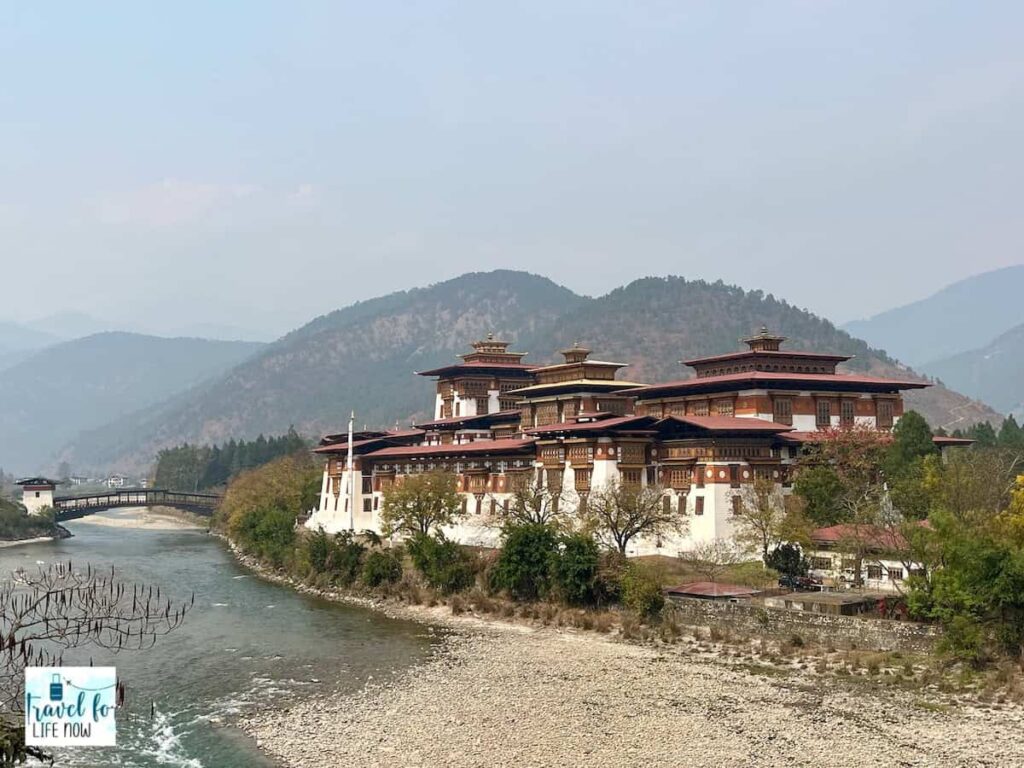
Visiting Chimi Lhakang Monastery
In 1499, Lama Drukpa Kuenley (aka The Divine Madman), built the Chimi Lhakang Monastery as a temple for fertility. The Divine Madman traveled throughout Bhutan and Tibet using songs and other behaviors to advocate for salvation through sex.
Walking to the Monastery, we saw penises everywhere—on the walls, in the shop windows. At the Temple, we even saw a woman walk around the grounds with a giant penis on her back. She was performing a fertility ceremony. It was quite a sight.
The Alternative Tiger’s Nest: Dzhongdrahka Goenpa
Dzhongdrahka Goenpa was a place suggested by Dorji. It is often known as the 2nd Taktsang given its cliffside perch like Tiger’s Nest. We were able to drive partway and then walked the rest of the way. It’s not a well-known site so we had it mainly to ourselves. We were very fortunate to have had tea with the abbot’s assistant inside the temple. We also had a chance to see one of the temples that was currently under renovation.
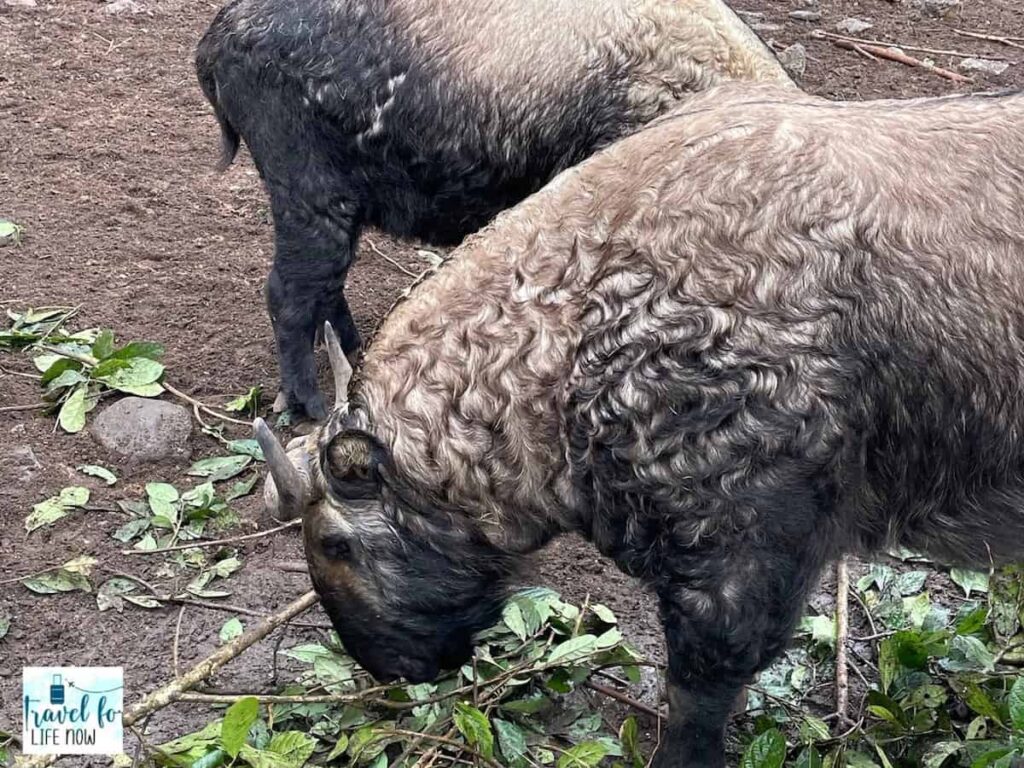
Additional Activities and Sites
We enjoyed visiting the Takin Preserve to see and learn about the national animal, the Takin. It’s an odd-looking animal. There are other animals to see as well. The Tashichho Dzong in Paro was impressive. It has been the seat of the Bhutanese government since 1968. The National Museum of Bhutan has artistic and historic treasures and is worth stopping by.
We also enjoyed making our own stamps at the post office with one of our photos from the trip. They are real stamps–we used them to mail postcards to friends. The paper factory is another interesting stop. They use traditional methods to make paper from the Daphne tree.
Gross National Happiness
Many people have asked us if Bhutan is the happiest place in the world. The short answer: it just might be.
Bhutan is a constitutional monarchy with a population of 700,000 people. The vast majority are Buddhists. The leadership and people try to live Buddhist values, compassion being one of them.
Jigme Khesar Namgyel Wangchuk (on our flight to Bhutan) is the current Druk Gyalpo (Dragon King) of Bhutan and is known as the people’s king. He oversaw the transformation of Bhutan into a constitutional monarchy. In 2021, he signed the law that decriminalized homosexuality.
Gross National Happiness (GNH) is a priority in Bhutan. All development goals need to take GNH into account. The government is also committed to sustainable tourism and conservation. It is estimated that 70% of the land in Bhutan is forested (more than the 60% goal). It is the only country in the world with a negative carbon footprint. While meat and fish are part of the Bhutanese diet, animals are not allowed to be slaughtered within the country.
Bhutanese have limited access to the wider world. There is almost no immigration into Bhutan and Bhutanese are often unable to obtain visas to visit, work, or study in other countries. It was one of the last countries in the world to have television and access to the internet which began in 1999. Many people are subsistence farmers and there is very little industry. We had a strong sense of the isolation of the country.
We found people to be very friendly, welcoming, and kind.
Upcoming posts will include the wonderful food as well as our meeting with LGBTQ+ leaders in Bhutan. Subscribe to our mailing to be kept informed.
For more on our travels to religious sites, see our post on Poya Day in Sri Lanka and Kampong Thom in Cambodia.
We’d love to hear from you–comments, questions, responses. If you found this post interesting, please share with others.
